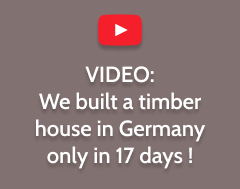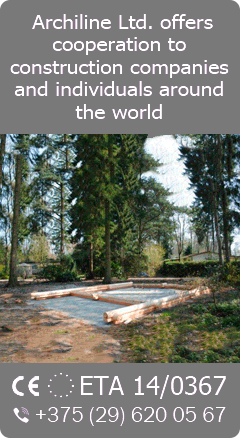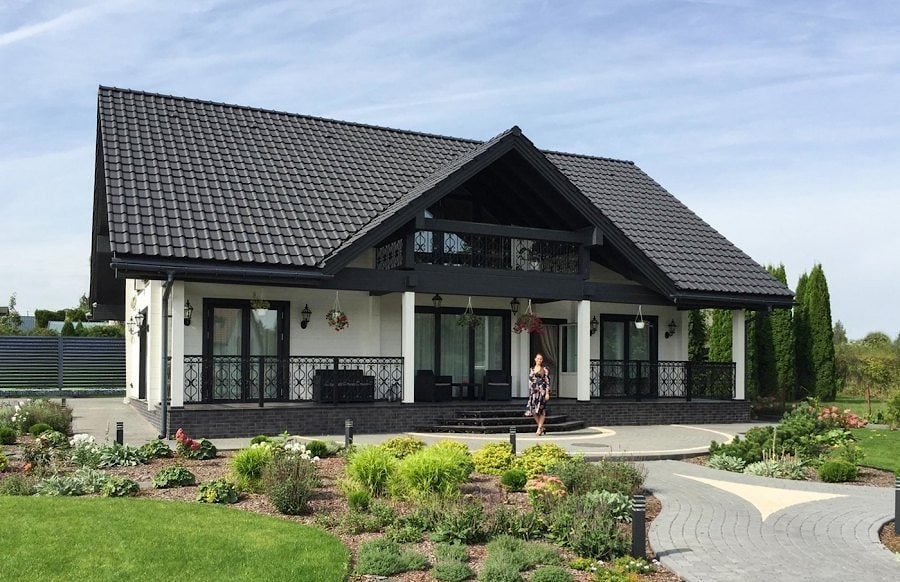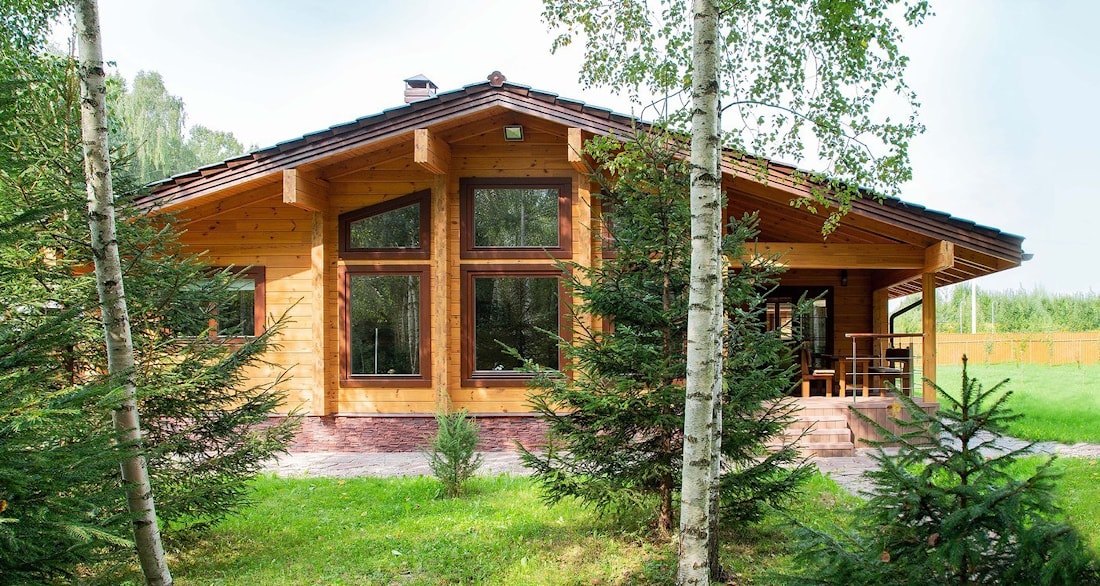≡ Menu
|
|
Types of roofing materials for the glulam house Types of roofing materials for the glulam house Types of roofing materials for the glulam house This article will discuss the main factors that you should consider when choosing a roofing material while building a glulam house. There will also be a description of the main types of roofing materials, their advantages and disadvantages. Content: 1. What does the choice of roofing material depends on 2. Types of roofing materials 3. Tile 4. Metal roofing 5. Bituminous slate 6. Slate roof 7. Roofs made of natural materials What does the choice of roofing material depends on The first thing to do when choosing the roofing material for you log cabin is that you should collect loads on roofs. The loading on the roof is made up of the roof own weight, i.e. the roof structure: the weight of the roof building construction (roof timber, counter batten, roofing, insulation, etc.) and the weight of snow cover that is specific to your region. Also, consider the power of the wind in the region. Architectural proposal of the roof From the reference glulam house design, it is clear what form the roof will have in the future wood home. Based on the shape, size, design features of the building roofing system design is selected and as well as its coverage. For example, selecting ceramic tile as a roofing material, the architect will need to keep the roof slope not less than 30-35 degrees, as it is required by the technology construction.  Operational life, fire resistance Depending on the operating conditions of the roof, durability and fire resistance of the roof the material should be selected. It goes without saying that there is no sense in constructing the roof "for centuries" for a storehouse, as well as there is no point in buying modern, expensive and technological materials. The warranty periods for roofing materials (if performing mandatory requirements and application conditions) are the following: - for the soft tiles usually 15-20 years (warranty is only valid on the roof leak resistance, non-existence of manufacturing defects, but the color is not covered under the warranty) - for metal tile roofing - 5-15 years (warranty period varies depending on the type of polymer coating and does not cover the equal color change, discoloration, changes due to pollution and gloss changes of the coating) - for natural tile - 20-30 years (there is an additional warranty on the resistance to frost, the warranty does not cover improper transportation, acid and vapors action) - for slate up to 10 years - bituminous channeled sheets up to 15 years (warranty is valid on the roof leak resistance, warranty does not cover color consistence) - profiled sheeting and roofing steel up to 15-20 years (warranty depends on whether there is coverage or not, and does not apply to mechanical damage caused during transportation and installation of products or after) - slate roofs - 30-40 years - seamed roof – 15-20 years In this case the actual durability can exceed these figures significantly. The approximate life of roofing materials without repair is: - soft tile - 30-50 years old, - metal tile roofing - 30-50 years old, - natural tile - 100-150 years, - slate 30-40 years - bitumen channeled sheets up to 15-25 years - profiled sheeting and roofing steel up to 50 years - slate roofs 150-200 years - seamed roof up to 50 years The golden mean between price and quality Every day in the construction industry, more and more kinds of roofing materials and structures appear. Each kind of such material should be approached critically, you should consider all the "pros" and "cons" when choosing the roofing material for your log house. The financial question in the building construction plays an important role, especially at the end of the construction, when money is less and less, and it is necessary to cover the roof with high quality material with a long term of service. You should not also overestimate the advantages of new materials that will be recommended by sales managers. There is no ideal materials for the roof that are suitable for any operating conditions yet. You should better get some advice from different sources and then determined the choice. Types of roofing materials At this moment the market is full of all sorts of roofing materials for every taste. Materials used for the roof covering must be not only hard, but also have a long term operating life, that is, to have a good ability to resist weathering (ability to withstand a variety of weather conditions - freezing temperatures, solar radiation, atmospheric oxygen, without impairing the material properties), heat conductivity factor, corrosion resistance, cold resistance . In this article we will discuss the most common types of roofing materials according to following points: How the roofing material is made. What types of each material are there. What is the minimum and the maximum slope of the roof structure, required for its use. How does the laying process flows (fundamental principles). What constructive preparing is required (roof construction, covering, a backing layer, etc.). What features are important when choosing the material and application of the material. Pros and cons of the roofing material. Tile Ceramic tile It is made of clay mass which passes molding and firing process in a furnace at about 1000 degrees, while it gets a red-brown color. It may also be glazed protective film which is applied before firing and serves for better removal of atmospheric precipitation. The finished product is a small-sized tiles (30 * 30cm) with a weight of 2 kg. There are different types of ceramic tile, depending on their position on the roof and the manufacturing method: an ordinary ceramic tile, English tile, grooving band, grooving stamped, single-wave, two-wave, grooved and others. When is the tiled roof used? Optimal roof pitch for tile is from 25-35 to 60 degrees: If a slope is less than 22 degrees it is necessary to carry out measures to improve waterproofing and ventilation. From 22 to 60 degrees tile material is fixed in a standard way When a slope is greater than 60 degrees there should be an additional mounting Tile is fastened to each other by means of a special system of locks and is secured to the batten by means of special holes - so tile rests on the upper bottom arranging continuous roofing mat, which prevents the roof leak. Working life of the tile roof without the need for repairs is more than 100-150 years (just remember the roofs of the old houses in Europe). This kind of material is used in brick, stone and wood houses.  Ceramic tile, the pros: - operating costs are minimized (cleaning gutters, valleys, contiguity inspection is usually done once a year, a simple local repair), - noise abatement (you will hear the sound of rain) - non-combustible, unlike most roofing materials - do not corrode - resistance to frost more than 1000 cycles - decorative appeal of the roof - a variety of shapes and colors, - roof design allows the roof to "breathe" - through micro-pores in its structure, thereby the moisture accumulating under the roof exhale. Ceramic tile, cons: - large weight, which leads to the increase in the cross sections of truss construction (or decrease of step of the cross-section with the same cut) - friability - when covering complex roof constructions entails technical difficulties (reinforced crate, greater consumption of fasteners, additional waterproofing). Sand-cement tile As it was said the ceramic tile has a large weight. In order to facilitate its construction sand-cement tile has been developed (instead of firing the reaction of setting of cement-sandy matrix under pressure was used). Now the square meter weighs 35-45kg. The structure includes tile cement, sand and iron oxide, which acts as a dye, that is, in appearance and design features sand-cement tile does not differ from ceramic tiles. This type of tile is available flat and profiled, glazed and without it. The slope at which it is applied varies from 20 to 60 degrees. Sand-cement tile are fastened to the sheathing with nails, nails are held in the holes that are made in it at the factory. The underlay under the sand-cement tile is a waterproofing carpet and sheathing. Another positive factor for the choice of sand-cement tile is a great color palette available. Tile is gaining strength over the years during its service life, it does not lose its technical properties. Cement-sand tile, the pros: - resistant to aggressive media and solar radiation, - frost (1000 cycles). Cement-sand tile, cons: - more massive compared to the ceramic (tile thickness is 10 mm) - high price - large percentage of breakage is possible during transportation (up to 10 percent due to improper transportation) Sand-cement tile, as well as ceramic, can be used in brick and wood houses of different heights, but its distinctive feature is the price, which is significantly less than the ceramic tile has. Thus covering your new wood home building you get the same decorative effect for less money. Shingles Shingles is made from fiberglass or cellulose and polyester which is applied to the bitumen tile and then it is covered with a special substance for coloring in some particular color. Such tiles is fairly reliable roofing material because it has a layer of bitumen-rubber coating that sticks together and makes one roofing carpet under the influence of sunlight. Usually it looks like a small-sized tiles, sheet length of about one meter and a standard width of 30 cm, it has a weight of 8-12kg square meter, has a triangular, rectangular or round shape, and large selection of colors. This tile is very plastic (it can be deformed hands without much effort) and resistant to precipitation, so you can repeat any intricate shape of the roof structure conceived in the wood house project. It is suitable for roofs with a slope greater than 12 degrees, and the maximum slope of the roof is not limited. Such tiles are used if you decide to give your roof an intricate, unusual shape, since it can easily be mounted with different slope and bend over any curved surface. It is also important to use underlayment , laid on a roof-sheathing of waterproof plywood. The backing layer is rolled out across the roof area (made from waterproof materials). Shingles is commonly in cottages, private houses, gazebos, garages, public buildings. Such tiles are also used in the renovation of old roofs (of roofing iron and of bituminous materials), making the new carpet from shingles directly over the prepared old.  Shingles, the pros: - it does not break during transportation and installation, - it is possible to update roof later quickly and inexpensively (local repair), - silent during precipitation, - it does not rust, - small amounts of waste, - not exposed to corrosion and rot. Shingles, cons: - traditionally considered not as "elite" as natural is, - high burning quality, - exposed to ultraviolet radiation (discolour in sunlight) - inability to mount in winter Metal Tile roofing Metal Tile roofing is a sheet of galvanized steel (bearing part) with a polymer coating (protecting and decorative purpose). The number and the connection of the layers differ depending on the manufacturer. Metal is really similar to the ceramic because of its texture, but it is only at first glance, in fact it is not the individual tiles but solid steel sheet with textured corrugated, with a thickness of 0.4 mm and a variety of available sizes. This type of tile is suitable for roofs with angle of slope of 15 degrees, and the maximum value of the slope is not limited. When angle of slope is up to 20%, the mandatory sealing joints should be made between metal decks. The material is simple enough to assemble -it is attached with nails or screws to the roof. The amount of overlap of metal along the ramp should be at least 250 mm, and the transverse slope on one corrugation. It is used almost everywhere, from temporary stalls and shopping centers to high-rise buildings and industrial facilities, and, of course, in private homes and cottages. If you want to save a lot of money (it is 2-3 times cheaper than the ceramic and cement-sand tiles), and the time and get a solid and durable roof then this option is for you. Metal tile can be used as a false roof, that is to make, for example, a flat roof and decorate it with the metal roofing around the perimeter. Metal Tile roofing, the pros: - quick installation, - resistance to mechanical stress, - affordable price. - small weight (square meter weights 3-5kg) - transportation convenience (does not break or crack) Metal Tile roofing, cons: - poor noise insulation (noise during rain and hail) - a large amount of waste during installation. Asbestos-cement board (Slate) Asbestos-cement board (Slate) - is a cement composite material, the consolidation of asbestos fibers. It is a mixture of short asbestos (15%) and Portland (85%).It is available in sheets of rectangular shape with a wavy corrugation, usually 6 Profile waves. Standard size of slate sheet is 1.2 * 0.7 m and height of waves from 28mm, weight per square meter of such a roof kind is from 10-15kg. The sheets are placed overlap and are attached to the crate with nails, under which soft sealing gasket is placed. When asbestos-cement board roof is installed it is recommended to underlay glassine paper or rubberoid. It is recommended to use slate roofing when the angle of the slopes is more than 12 degrees and up to 60 degrees. Nowadays this material is not so popular in glulam houses projects. Such roofing materials are used mostly for minor importance buildings (sheds, summer kitchen, commercial blocks, fences), although sometimes it can be used for roof covering in cottage homes when the owners want to save. Asbestos-cement board, the pros: - good strength properties - well-cut with angle grinder, - relatively low price. Asbestos-cement board, cons: - fragile, - harmfulness of asbestos to humans, - decorative unattractive, - can accumulate moisture, because of that it may lose color, fungus and moss begin to live on it over time. Metal roofs Corrugated sheets The easiest type of coating is made of galvanized steel sheets. It can be said that the metal sheets is a precursor of modern metal tile roofing. Corrugated sheets - is profiled or corrugated material, it has increased rigidity and the sheets are made of galvanized steel (coated or not). Waves on the corrugated sheets have a different height and shape: trapezium, sinusoid, rounded. Curl simplifies docking and attaches decorative appeal. Corrugated sheets are produce in different size, depending on the manufacturer and the material. The minimum slope required is 10 degrees, the maximum is not standardized. It is mounted on a roof-sheathing of timber with the laying of glassine paper( to increase the water retaining properties) and fastened by self-drilling screws. The average consumption of fastening element is 6-8 pcs. per 1 m2 of the coating. Corrugated sheets can be covered the old roll roofing (during the reconstruction and repair of the roof). Corrugated sheets are mainly applicable for economic construction (shed, utilities area) and industrial buildings (car washes, supermarkets, factories). Corrugated sheets, pros: - simple and fast installation, - high cross breaking strength - inexpensive material - long period of service Corrugated sheets, cons: - Low insulation Roofs made of natural materials Roofs made of natural materials include such roofing materials as straw, reeds, wood (shingles), turf roof. Such roofs nowadays are mostly elite exception. These unusual and environmentally friendly materials are suitable for exclusive coatings. Roofs made of reed, wood, straw are efficient on commercial buildings, for example restaurants, hotels and bars. As practice shows, roofs made of natural materials on these types of buildings attract more visitors than neon and bright facades. Also, such type of roofing creates special look to house, cottage, garden-house. In this article, we reviewed the various types of roofing. It should be noted that during roof material choosing it is important to consult manufacturer or supplier about the quality, delivery options, guarantees, installation and other important points. As well as the view of the architect or your glulam home project designer is also usefull. 
Look more:You can see a video-review of the wooden house “Mirage”:You can have a look on 3D-tour of the wooden house «Mirage»:
Wooden house "Mirage" from profiled glued timber 99m2We speak English, German, Turkish, French and Russian +375298-06-05-67 -- WhatsApp, Telegram, Viber Look more: Wooden house made of glued laminated timber "White House"Look more:You can see a video-review of the wooden house "Mirage":Wooden house "Mirage" from profiled glued timber 99m2If you want to buy types of roofing materials for the glulam house , you can:
Call: More from section Roof of a wooden house |
|
© 2025
ArchiLine Wooden Houses
114-49, Necrasov str., Minsk, Republic of Belarus, 220049
The site is powered by Nestorclub.com google.com, pub-6447061049723989, DIRECT, f08c47fec0942fa0 | |
 Good Wooden House since 2004
Good Wooden House since 2004









